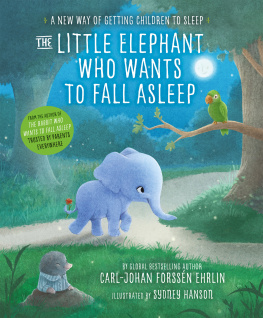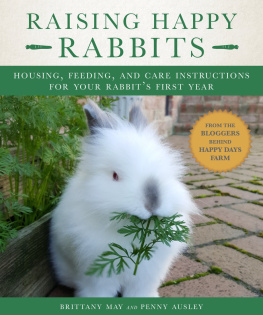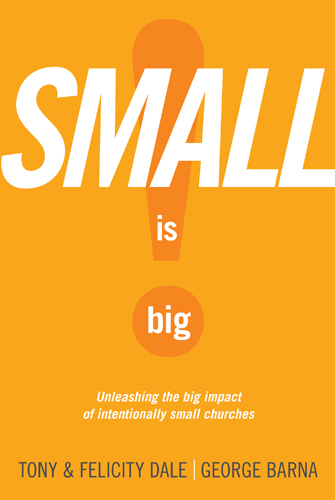Visit Tyndales exciting Web site at www.tyndale.com.
TYNDALE is a registered trademark of Tyndale House Publishers, Inc.
Barna and the Barna logo are trademarks of George Barna.
BarnaBooks is an imprint of Tyndale House Publishers, Inc.
Small Is Big!: Unleashing the Big Impact of Intentionally Small Churches
Copyright 2009, 2011 by Tony and Felicity Dale, and George Barna. All rights reserved.
Designed by Jessie McGrath
Published in association with the literary agency of Fedd and Company Inc., 9759 Concord Pass, Brentwood, TN 37027.
All Scripture quotations, unless otherwise indicated, are taken from the New King James Version. Copyright 1982 by Thomas Nelson, Inc. Used by permission. All rights reserved.
Scripture quotations marked NASB are taken from the New American Standard Bible, copyright 1960, 1962, 1963, 1968, 1971, 1972, 1973, 1975, 1977, 1995 by The Lockman Foundation. Used by permission.
Scripture quotations marked NIV are taken from the Holy Bible, New International Version , NIV . Copyright 1973, 1978, 1984 by Biblica, Inc. TM Used by permission of Zondervan. All rights reserved worldwide. www.zondervan.com.
Scripture quotations marked ESV are taken from The Holy Bible , English Standard Version, copyright 2001 by Crossway Bibles, a publishing ministry of Good News Publishers. Used by permission. All rights reserved.
Scripture quotations marked NLT are taken from the Holy Bible , New Living Translation, copyright 1996, 2004, 2007 by Tyndale House Foundation. Used by permission of Tyndale House Publishers, Inc., Carol Stream, Illinois 60188. All rights reserved.
The Library of Congress has catalogued the original edition as follows:
Dale, Tony.
The rabbit and the elephant : why small is the new big for todays church /
Tony and Felicity Dale.
p. cm.
Includes bibliographical references and index.
ISBN 978-1-4143-2553-8 (hc : alk. paper) 1. Church growth. 2. Small churches. I. Dale, Felicity. II. Title.
BV652.25.D35 2009
262.26dc22 2009002215
ISBN 978-1-4143-3941-2 (sc)
To Jon, Matt, Tim, and Becky, who had no choice about coming on the journey with us.
Introduction
We are in rural India and it is hotso hot that the sweat is dripping down our faces. The oppressive heat is compounded by the number of bodies packed into a room without air-conditioning for this conference on church planting. The women, like exotic tropical flowers in their colorful saris, brighten the otherwise drab surroundings. It has been a long day. Although we have frequently broken things up with different activities, the concrete floor gets very hard after a few hourswe, the honored Western visitors and our interpreter, are the only ones privileged to have chairs. Its time for some light relief.
Imagine you take two elephants...
The audience perks up. They sense a story is coming.
For our purposes, they are a male and a female.
Small titter.
And you put them in that room behind us (pointing to a tiny kitchen off the main room).
More laughter. They know you couldnt possibly fit one elephant into that room, let alone two!
You give them plenty to eat and drink and you shut the door on them. Three years later, you come back and open the door. What comes out?
A number of people call something out. We look to our interpreter for help.
They say that three elephants come out. Mom, Dad, and a baby.
Thats good. In three years, Mom and Dad elephant have had one baby! Now, instead of two elephants, lets pretend you put two rabbits in the room.
They start to chuckle. Already they can anticipate what is coming.
At the end of three years, when you open the door, you had better run for your life, because millions of rabbits will explode out of that door.
The room erupts in laughter!
But they have also caught the point. Something that is large and complex is hard to reproduce. Something that is small and simple multiplies easily. Elephants take a long time to reach maturity and have a long gestation period. It takes time to reproduce a single elephant. Rabbits, on the other hand, are extremely fertile all the time. They reach maturity in four to six months, and their gestation period is a mere thirty days. Hence the expression breed like rabbits.
We learned this story from others, but it doesnt matter where in the world we gofrom primitive rural India to the sophisticated cities of the Westpeople relate to the analogy and instinctively apply it to church planting.
God always intended for His church to multiply. Although multiplication starts slowly, it is infinitely more effective than addition in the long term. Churches that are intentionally small (simple churches, organic churches, house churches) can reproduce easily and with virtually no cost. They have the potential for rapid multiplication because anyone can gather a few people together in a living room or coffee shop. And they are very easy to duplicate. Not only that, but they also penetrate sectors of society that will never enter a church building. Thats why small is big!
Jesus is building His church. Across the nations, the proliferation of intentionally small churches is having a major impact. Lets follow Jesus into the harvest, make disciples, and see multiplying families of His people transform our world.
In the Beginning
Charles Dickens begins his novel A Tale of Two Cities with the haunting phrase It was the best of times, it was the worst of times.... For us, these words had become an overwhelming reality.
We arrived in the United States in 1987 with high hopes and great expectations. We had come from the concrete jungles of Londons East End to the wide-open spaces of Texas. We had left behind a cold, rainy, windblown island for the balmy temperatures and sun-filled days of the Texas hill country. We loved the food, enjoyed the people, liked the city. Our four kids reveled in the unrestricted access to the outdoors and a swimming pool to share with their new friends. It was indeed the best of times.
It was also the worst of times. God had abandoned usat least thats what it felt like. He had led us to move to Texas, but as soon as we arrived at the airport, it seemed like He deserted us and took the next plane back to England, leaving us to fend for ourselves!
How could we have come to this?
We had met at the prestigious Royal and Ancient Hospital of Saint Bartholomew (Barts Hospital, founded in 1123). It was love at first sight over the histology microscope. Thats not quite true, but because there were so few Christians in the school (just 4 of us out of 150 students in our class), we were constantly thrown together, and a deep friendship developed. We soon sensed God leading us to get married.
By this time, England was already post-Christian, so all of the believers in the medical school and hospitaleveryone from nurses and medical students to physical therapists and janitors and even a few of the qualified doctorsformed a close-knit community. Because we all spent so much of our time togetherstudying and working at the hospitalwe gradually came to the realization that we were functioning more as a church within the hospital than we did as members of the traditional churches we each attended on Sunday. So we decided to take the unlikely step of actually calling ourselves a church. This was a highly controversial move at the time. Everyone expected church to be run by professionals. However, it did give us the dubious satisfaction of a certain notoriety, as we were thrown out of the organization that united student Christian groups across the nation and preached against from some of the best-known pulpits in London!










